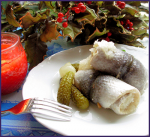Ah so, it makes sense why things cooked over a campfire have that extra special something something. Wood scents are among those I favor, Cassia especially, which I believe is a type of cinnamon bark.
And if Anise is a type of licorice, I don't particularly dislike black licorice, but I can't eat very many of those at a time either.
I happened on a pack of licorice seeds and thought that to be a particularly novel find, especially because I didn't know where licorice came from, so I bought them. They were black rice-grain like seeds that sprouted like weeds, and produced even more when it went to seed because I didn't know what to do with them. So, I shook some of the seeds into a paper sack and brought them to mom's who scattered them into a corner of her garden, and it wasn't long that more sprang up there also. But, before they went to seed, she pulled them up (the green) and incorporated them into a delicious beef dish. And, if I'd have known how delicious, I'd have made sure that she allow more to go to more seed... because I haven't been able to find them ever since.
And if Anise is a type of licorice, I don't particularly dislike black licorice, but I can't eat very many of those at a time either.
I happened on a pack of licorice seeds and thought that to be a particularly novel find, especially because I didn't know where licorice came from, so I bought them. They were black rice-grain like seeds that sprouted like weeds, and produced even more when it went to seed because I didn't know what to do with them. So, I shook some of the seeds into a paper sack and brought them to mom's who scattered them into a corner of her garden, and it wasn't long that more sprang up there also. But, before they went to seed, she pulled them up (the green) and incorporated them into a delicious beef dish. And, if I'd have known how delicious, I'd have made sure that she allow more to go to more seed... because I haven't been able to find them ever since.
There may be a few plants at any garden center with the word ‘licorice’ in the title. Most of them
are licorice scented and aren’t the medicinal variety with the usable root. They’re usually inedible.
Look for Glycyrrhiza glabra, which is the European variety that has the familiar flavor. There is a licorice
variety that is native to the U.S called Glycyrrhiza lepidota, though it’s much less intense in flavor.
Glycyrrhiza uralensis is also known as Chinese licorice. It has a sweet flavor and multiple medicinal uses. source
-
2
-
1
-
1
- Show all


